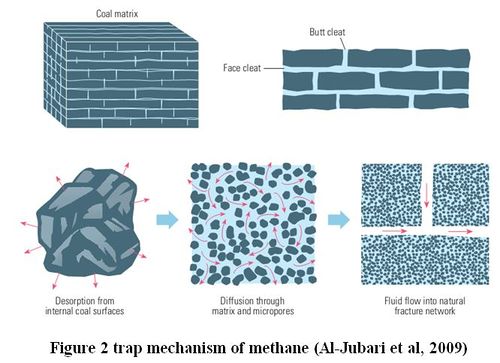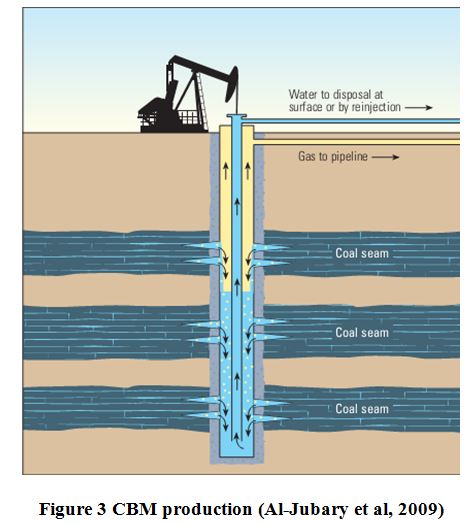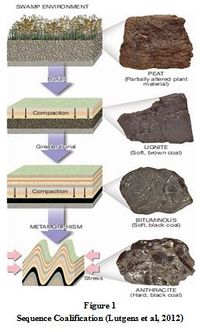Coal bed methane (UB)
| Wiki Write-Off Entry | |
|---|---|

| |
| Student Chapter | University of Brawijaya |
| Competition | June 2015 |
Coal Bed Methane (CBM) is unconventional natural gas which comes from coal. CBM can be used as energy alternative beside hidrocarbon. Coal that used as source CBM provides 25% world energy. CBM resources predicted about 9000 TCF, mainly in North America (3000 TCF) and other country former Soviet Union (4000 TCF).
CBM fistly used around coal mining. Coal mines can simultaneoustly produce methane and consume it by generating electricity. The electricty can be used to operate many instrument in around coal mining. Then electicity from CBM can be selling to power supplier for cost recovery in coal mines.
Origin of Coal
Coal is a sedimentary rock with rich organic material that compacts in the coalification process. Coal is constructed in an environment with low oxygen content, such as swamps or bogs. Coal is easily known by its black color. Furthermore, if seen under a microscope it is apparent that it is the remains of plants that are not fully decayed, such as leaves and roots.
Initially, coal forms when it accumulates plant remains with anoxic conditions, so plant cannot decay. Instead, the plants are attacked by bacteria that partly decomposes the organic material and liberates oxygen and hydrogen. When those elements come out, the percentage of carbon increases. Bacteria cannot fully decompose organic material because they are destroyed by acids liberated from plants.[2]
Plant remains accumulates into a peat where plant material is easily known. Then peat slowly changes to lignite (brown coal), which is an early stage of coal formation. Because of the burial conditions, pressure and temperature increase. These increases make a chemical reaction where coal loses water and gas and increases carbon concentration. Lignite then becomes bituminus coal, which has higher carbon concentration. If pressure and temperature increase coal bituminus become antracite, black coal, with highest carbon concentration.
Coal classified by degree of coalification (increasing organic carbon content) in terms of coal rank (Table 1). Lignite and sub-bituminus are low rank coal with low carbon content. Bituminus is middle rank and the highest rank coal are known as antracite which has the highest carbon concentration.[3]

Gas in CBM
Most CBM has been produced by microbial, thermal, or possibly catalytic degradation of organic material present in coal. CBM is mainly composed of methane (CH4) with variable additions of carbon dioxide (CO2), elemental nitrogen (N2), and heavier hydrocarbon, such as ethane (C2H6), and traces of propane (C3H8) and butanes (C4H10).[4]
CBM Storage
Trap mechanisms of CBM differ from conventional gas. In conventional gas, gas is trapped in the porosity of rock. But in CBM, methane is trapped in the microporosity of coal. This microporosity has the capacity to store six times more gas than conventional gas. This microporosity created when coal began coalification process. When temperature and pressure of coal increase, matrix in coal decrease create micro pore that trap methane. The increase fracture also making fracture or cleats in coal, so making permeability in coal (Figure 2).

CBM Production
Methane trapped in microporosity can be produced by dewatering. Dewatering is a process to displace methane using water. Methane pulled to well bore with decreasing formation pressure. Water than moving into well bore with methane inside of water. And then water and methane separated, methane will be save in storage and water will be injected again to subsurface. CBM has slow rate production. To increase production usually stimulated with hydrolic fracture to increase permeability of coal (Figure 3).

Future CBM
CBM in future has many economic potential. It can be used to generate electricity. Not only around the coal mining site but also can be pipelined for utility and industrial use. Electricity can be selling to power supplier to be piped to other town. Some of CBM potential is already realized.
References
- ↑ 1.0 1.1 Carlson, D., and C. Plummer, 2008, Physical geology: Earth revealed: New York, McGraw-Hill, 672 p.
- ↑ Lutgens, F. K., E. J. Tarbuck, and D. G., 2012, Essentials of Geology: Upper Saddle River, New Jersey, Pearson Prentice Hall, 592 p.
- ↑ Nichols, G., 2009, Sedimentology and stratigraphy: Hoboken, New Jersey, Wiley Blackwell, 432 p.
- ↑ Thakur, P., S. Schatzel, and K. Aminian, eds., 2014, Coal bed methane—from prospect to pipeline: Amsterdam, Elsevier, 440 p.
- ↑ Al-Jubori, A., S. Johnston, C. Boyer, S. W. Lambert, O. A. Bustos, J. C. Pashin, and A. Wray, 2009, Coalbed methane: Clean energy for the world: Schlumberger Oilfield Review, v. 21, p. 6-13
- ↑ Al-Jubary et al. 2009. Oilfield Review Summer 2009.21: Schlumberger
